seats BUICK LACROSSE 2009 Owner's Manual
[x] Cancel search | Manufacturer: BUICK, Model Year: 2009, Model line: LACROSSE, Model: BUICK LACROSSE 2009Pages: 428
Page 1 of 428
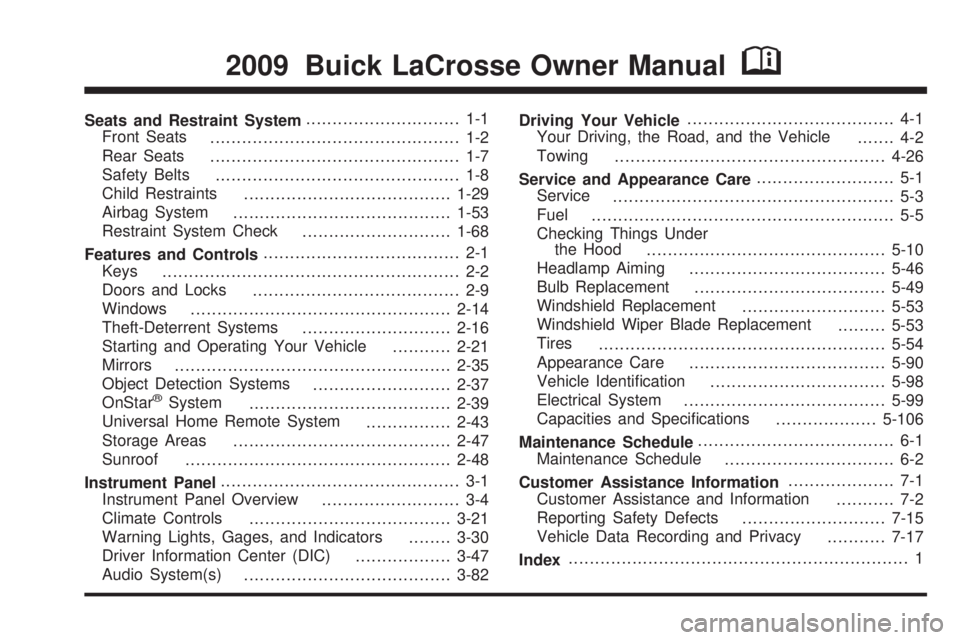
Seats and Restraint System............................. 1-1
Front Seats
............................................... 1-2
Rear Seats
............................................... 1-7
Safety Belts
.............................................. 1-8
Child Restraints
.......................................1-29
Airbag System
.........................................1-53
Restraint System Check
............................1-68
Features and Controls..................................... 2-1
Keys
........................................................ 2-2
Doors and Locks
....................................... 2-9
Windows
.................................................2-14
Theft-Deterrent Systems
............................2-16
Starting and Operating Your Vehicle
...........2-21
Mirrors
....................................................2-35
Object Detection Systems
..........................2-37
OnStar
®System
......................................2-39
Universal Home Remote System
................2-43
Storage Areas
.........................................2-47
Sunroof
..................................................2-48
Instrument Panel............................................. 3-1
Instrument Panel Overview
.......................... 3-4
Climate Controls
......................................3-21
Warning Lights, Gages, and Indicators
........3-30
Driver Information Center (DIC)
..................3-47
Audio System(s)
.......................................3-82Driving Your Vehicle....................................... 4-1
Your Driving, the Road, and the Vehicle
....... 4-2
Towing
...................................................4-26
Service and Appearance Care.......................... 5-1
Service
..................................................... 5-3
Fuel
......................................................... 5-5
Checking Things Under
the Hood
.............................................5-10
Headlamp Aiming
.....................................5-46
Bulb Replacement
....................................5-49
Windshield Replacement
...........................5-53
Windshield Wiper Blade Replacement
.........5-53
Tires
......................................................5-54
Appearance Care
.....................................5-90
Vehicle Identi�cation
.................................5-98
Electrical System
......................................5-99
Capacities and Speci�cations
...................5-106
Maintenance Schedule..................................... 6-1
Maintenance Schedule
................................ 6-2
Customer Assistance Information.................... 7-1
Customer Assistance and Information
........... 7-2
Reporting Safety Defects
...........................7-15
Vehicle Data Recording and Privacy
...........7-17
Index................................................................ 1
2009 Buick LaCrosse Owner ManualM
Page 5 of 428

Front Seats......................................................1-2
Power Seats..................................................1-2
Power Lumbar ...............................................1-3
Heated Seats.................................................1-3
Reclining Seatbacks........................................1-4
Head Restraints.............................................1-6
Center Seat...................................................1-7
Rear Seats.......................................................1-7
Split Folding Rear Seat...................................1-7
Safety Belts.....................................................1-8
Safety Belts: They Are for Everyone.................1-8
How to Wear Safety Belts Properly.................1-13
Lap-Shoulder Belt.........................................1-22
Safety Belt Use During Pregnancy..................1-27
Lap Belt......................................................1-28
Safety Belt Extender.....................................1-29
Child Restraints.............................................1-29
Older Children..............................................1-29
Infants and Young Children............................1-33
Child Restraint Systems.................................1-37
Where to Put the Restraint.............................1-40Lower Anchors and Tethers for
Children (LATCH)......................................1-41
Securing a Child Restraint in a Rear
Seat Position............................................1-47
Securing a Child Restraint in the Center
Front Seat Position....................................1-49
Securing a Child Restraint in the Right
Front Seat Position....................................1-50
Airbag System...............................................1-53
Where Are the Airbags?................................1-56
When Should an Airbag In�ate?.....................1-58
What Makes an Airbag In�ate?.......................1-59
How Does an Airbag Restrain?.......................1-59
What Will You See After an Airbag In�ates?.....1-60
Passenger Sensing System............................1-61
Servicing Your Airbag-Equipped Vehicle..........
.1-66
Adding Equipment to Your Airbag-Equipped
Vehicle....................................................1-67
Restraint System Check..................................1-68
Checking the Restraint Systems......................1-68
Replacing Restraint System Parts
After a Crash............................................1-69
Section 1 Seats and Restraint System
1-1
Page 6 of 428

Front Seats
Power Seats
If the vehicle has power seats, the controls used to
operate them are located on the outboard side of the
seats. To adjust the seat, do any of the following:
Move the seat forward or rearward by sliding the
control forward or rearward.
Raise or lower the front part of the seat cushion by
moving the front of the control up or down.
Raise or lower the rear part of the seat cushion by
moving the rear of the control up or down.
Raise or lower the entire seat by moving the entire
control up or down.
Driver Side shown, Passenger Side similar
1-2
Page 7 of 428
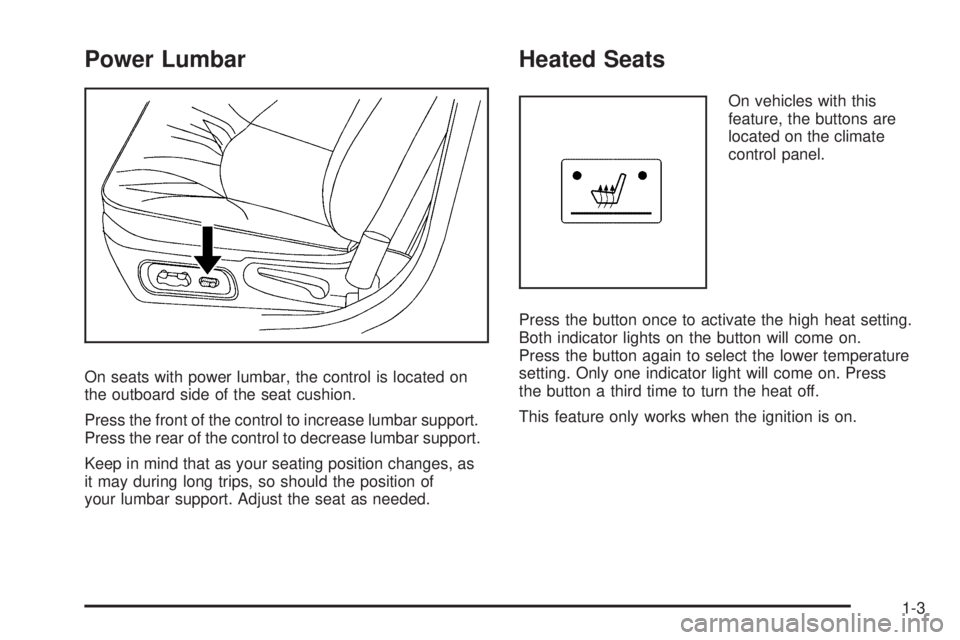
Power Lumbar
On seats with power lumbar, the control is located on
the outboard side of the seat cushion.
Press the front of the control to increase lumbar support.
Press the rear of the control to decrease lumbar support.
Keep in mind that as your seating position changes, as
it may during long trips, so should the position of
your lumbar support. Adjust the seat as needed.
Heated Seats
On vehicles with this
feature, the buttons are
located on the climate
control panel.
Press the button once to activate the high heat setting.
Both indicator lights on the button will come on.
Press the button again to select the lower temperature
setting. Only one indicator light will come on. Press
the button a third time to turn the heat off.
This feature only works when the ignition is on.
1-3
Page 8 of 428
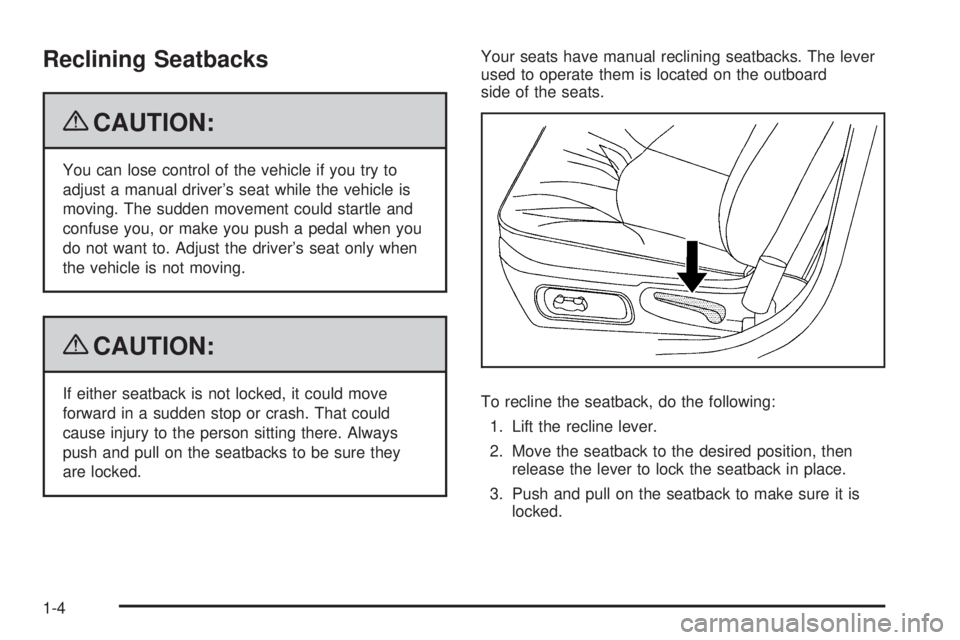
Reclining Seatbacks
{CAUTION:
You can lose control of the vehicle if you try to
adjust a manual driver’s seat while the vehicle is
moving. The sudden movement could startle and
confuse you, or make you push a pedal when you
do not want to. Adjust the driver’s seat only when
the vehicle is not moving.
{CAUTION:
If either seatback is not locked, it could move
forward in a sudden stop or crash. That could
cause injury to the person sitting there. Always
push and pull on the seatbacks to be sure they
are locked.Your seats have manual reclining seatbacks. The lever
used to operate them is located on the outboard
side of the seats.
To recline the seatback, do the following:
1. Lift the recline lever.
2. Move the seatback to the desired position, then
release the lever to lock the seatback in place.
3. Push and pull on the seatback to make sure it is
locked.
1-4
Page 11 of 428
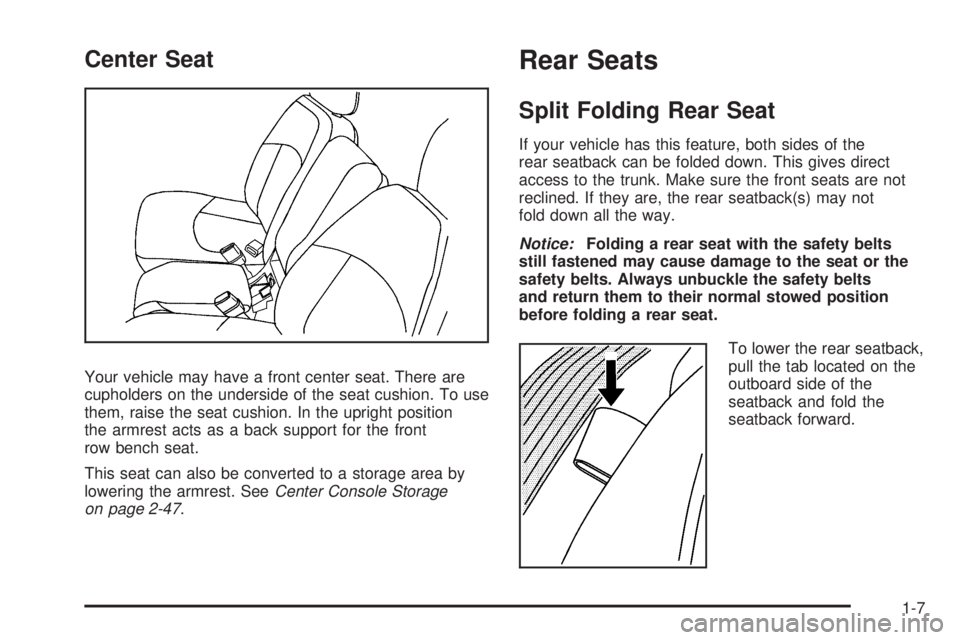
Center Seat
Your vehicle may have a front center seat. There are
cupholders on the underside of the seat cushion. To use
them, raise the seat cushion. In the upright position
the armrest acts as a back support for the front
row bench seat.
This seat can also be converted to a storage area by
lowering the armrest. SeeCenter Console Storage
on page 2-47.
Rear Seats
Split Folding Rear Seat
If your vehicle has this feature, both sides of the
rear seatback can be folded down. This gives direct
access to the trunk. Make sure the front seats are not
reclined. If they are, the rear seatback(s) may not
fold down all the way.
Notice:Folding a rear seat with the safety belts
still fastened may cause damage to the seat or the
safety belts. Always unbuckle the safety belts
and return them to their normal stowed position
before folding a rear seat.
To lower the rear seatback,
pull the tab located on the
outboard side of the
seatback and fold the
seatback forward.
1-7
Page 13 of 428
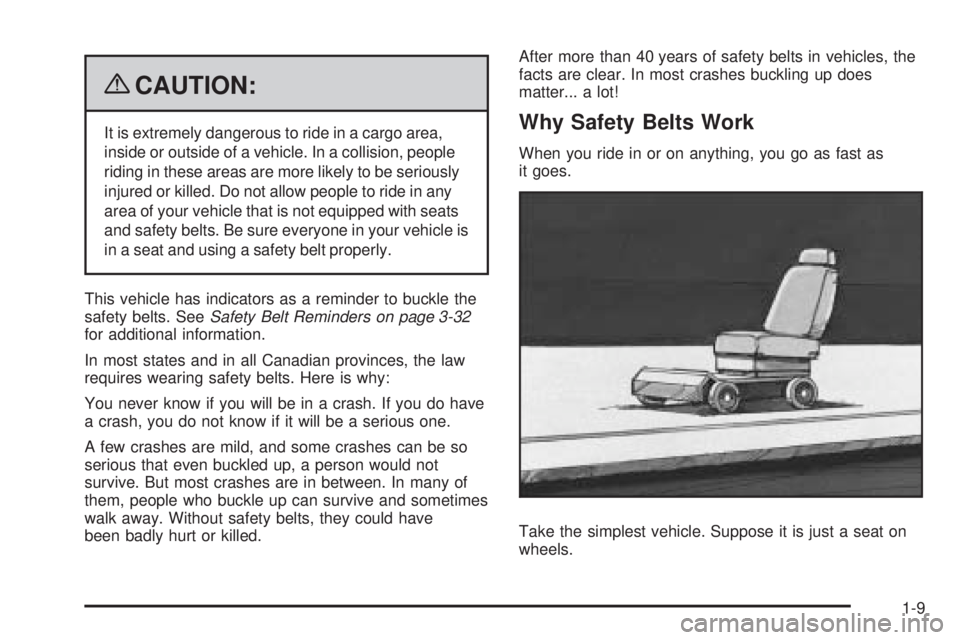
{CAUTION:
It is extremely dangerous to ride in a cargo area,
inside or outside of a vehicle. In a collision, people
riding in these areas are more likely to be seriously
injured or killed. Do not allow people to ride in any
area of your vehicle that is not equipped with seats
and safety belts. Be sure everyone in your vehicle is
in a seat and using a safety belt properly.
This vehicle has indicators as a reminder to buckle the
safety belts. SeeSafety Belt Reminders on page 3-32
for additional information.
In most states and in all Canadian provinces, the law
requires wearing safety belts. Here is why:
You never know if you will be in a crash. If you do have
a crash, you do not know if it will be a serious one.
A few crashes are mild, and some crashes can be so
serious that even buckled up, a person would not
survive. But most crashes are in between. In many of
them, people who buckle up can survive and sometimes
walk away. Without safety belts, they could have
been badly hurt or killed.After more than 40 years of safety belts in vehicles, the
facts are clear. In most crashes buckling up does
matter... a lot!Why Safety Belts Work
When you ride in or on anything, you go as fast as
it goes.
Take the simplest vehicle. Suppose it is just a seat on
wheels.
1-9
Page 26 of 428

Lap-Shoulder Belt
All seating positions in the vehicle have a lap-shoulder
belt except for the center front passenger position, if
your vehicle has one, which has a lap belt. SeeLap Belt
on page 1-28for more information.
The following instructions explain how to wear a
lap-shoulder belt properly.
1. Adjust the seat, if the seat is adjustable, so you can
sit up straight. To see how, see “Seats” in the Index.
2. Pick up the latch plate and pull the belt across you.
Do not let it get twisted.
The lap-shoulder belt may lock if you pull the belt
across you very quickly. If this happens, let the belt
go back slightly to unlock it. Then pull the belt
across you more slowly.
If the shoulder portion of a passenger belt is pulled
out all the way, the child restraint locking feature
may be engaged. If this happens, let the belt
go back all the way and start again.3. Push the latch plate into the buckle until it clicks.
If you �nd that the latch plate will not go fully into
the buckle, check if the correct buckle is being used.
Pull up on the latch plate to make sure it is
secure. If the belt is not long enough, seeSafety
Belt Extender on page 1-29.
Position the release button on the buckle so that
the safety belt could be quickly unbuckled if
necessary.
1-22
Page 28 of 428
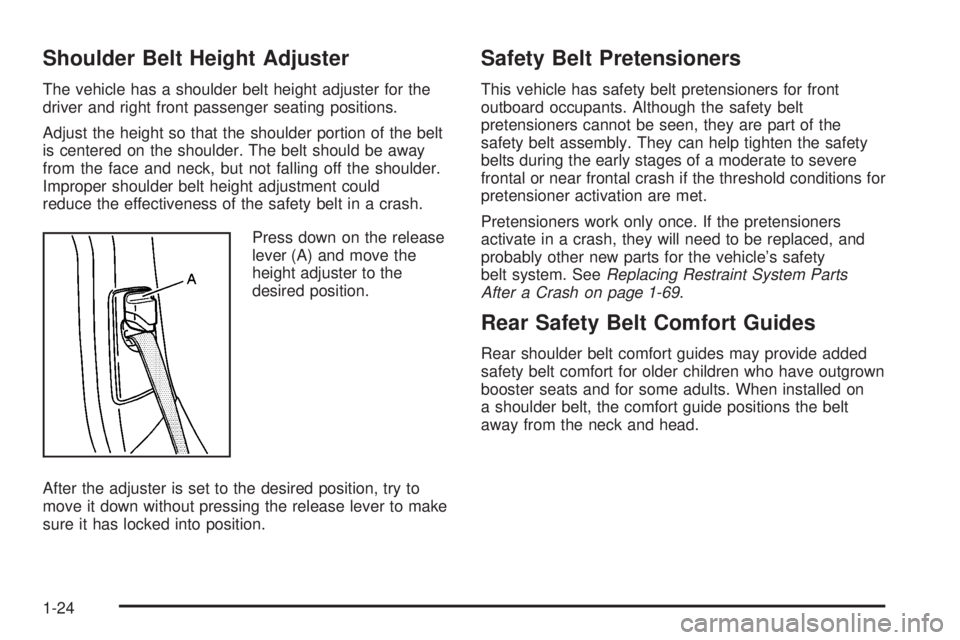
Shoulder Belt Height Adjuster
The vehicle has a shoulder belt height adjuster for the
driver and right front passenger seating positions.
Adjust the height so that the shoulder portion of the belt
is centered on the shoulder. The belt should be away
from the face and neck, but not falling off the shoulder.
Improper shoulder belt height adjustment could
reduce the effectiveness of the safety belt in a crash.
Press down on the release
lever (A) and move the
height adjuster to the
desired position.
After the adjuster is set to the desired position, try to
move it down without pressing the release lever to make
sure it has locked into position.
Safety Belt Pretensioners
This vehicle has safety belt pretensioners for front
outboard occupants. Although the safety belt
pretensioners cannot be seen, they are part of the
safety belt assembly. They can help tighten the safety
belts during the early stages of a moderate to severe
frontal or near frontal crash if the threshold conditions for
pretensioner activation are met.
Pretensioners work only once. If the pretensioners
activate in a crash, they will need to be replaced, and
probably other new parts for the vehicle’s safety
belt system. SeeReplacing Restraint System Parts
After a Crash on page 1-69.
Rear Safety Belt Comfort Guides
Rear shoulder belt comfort guides may provide added
safety belt comfort for older children who have outgrown
booster seats and for some adults. When installed on
a shoulder belt, the comfort guide positions the belt
away from the neck and head.
1-24
Page 33 of 428

Safety Belt Extender
If the safety belt will fasten around you, you should
use it.
But if a safety belt is not long enough, your
dealer/retailer will order you an extender. When you go
in to order it, take the heaviest coat you will wear,
so the extender will be long enough for you. To help
avoid personal injury, do not let someone else use
it, and use it only for the seat it is made to �t. The
extender has been designed for adults. Never use it for
securing child seats. To wear it, attach it to the
regular safety belt. For more information, see the
instruction sheet that comes with the extender.
Child Restraints
Older Children
Older children who have outgrown booster seats should
wear the vehicle’s safety belts.
1-29